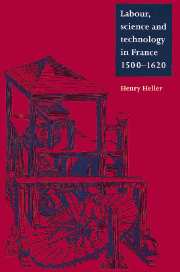Book contents
- Frontmatter
- Contents
- List of illustrations
- Preface
- List of abbreviations
- Introduction
- 1 The expansion of Parisian merchant capital
- 2 Labour in Paris in the sixteenth century
- 3 Civil war and economic experiments
- 4 Inventions and science in the reign of Charles IX
- 5 Expropriation, technology and wage labour
- 6 The Bourbon economic restoration
- 7 Braudel, Le Roy Ladurie and the inertia of history
- Bibliography
- Index
- CAMBRIDGE STUDIES IN EARLY MODERN HISTORY
6 - The Bourbon economic restoration
Published online by Cambridge University Press: 01 October 2009
- Frontmatter
- Contents
- List of illustrations
- Preface
- List of abbreviations
- Introduction
- 1 The expansion of Parisian merchant capital
- 2 Labour in Paris in the sixteenth century
- 3 Civil war and economic experiments
- 4 Inventions and science in the reign of Charles IX
- 5 Expropriation, technology and wage labour
- 6 The Bourbon economic restoration
- 7 Braudel, Le Roy Ladurie and the inertia of history
- Bibliography
- Index
- CAMBRIDGE STUDIES IN EARLY MODERN HISTORY
Summary
… we are in our lands more ingenious and subtle in all things since the greatest part of the arts … have either been invented or brought to their perfection here.
Nicholas Briot, Response … (1617)In 1595 the wars of religion came to an end. France embarked on the road to recovery under Henri IV and his minister Maximilien de Sully. The limits and extent of this economic revival at the end of the sixteenth and beginning of the seventeenth century are suggested by a study of the textile industry in the north of the kingdom by Pierre Devon. According to Deyon, a recovery began at the end of the 1590s which quickly brought the level of production back to the highest points of the sixteenth century. Expansion, although more irregular after 1600, continued until 1628. Agrarian crises in 1617–18 and 1625 interrupted production, as did a brutal commercial collapse in 1614 which was linked to a Europe-wide crisis. But growth, however interrupted, continued until the late 1620s, when a definitive tendency towards decline set in.
Deyon's view is reinforced by Pierre Jeannin's study of the mining industry in the southern Vosges. A vigorous economic revival is visible there during the closing years of the sixteenth century.
- Type
- Chapter
- Information
- Labour, Science and Technology in France, 1500–1620 , pp. 157 - 196Publisher: Cambridge University PressPrint publication year: 1995

